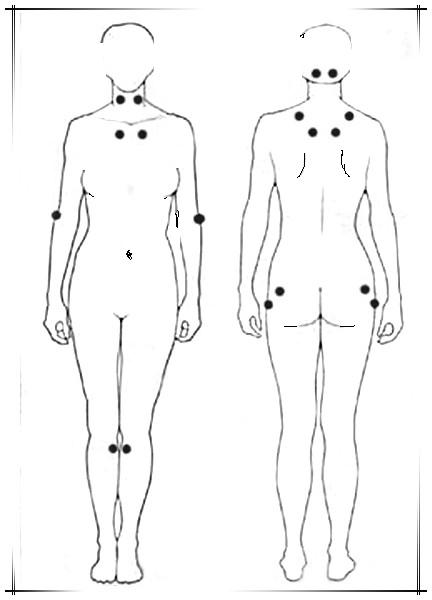Fibromyalgia is a disorder characterized by widespread musculoskeletal pain accompanied by fatigue, sleep, memory and mood issues.
Fibromyalgia is diagnosed when there is a history of widespread pain in all four quadrants of the body for a minimum duration of three months and pain when pressure is applied to at least 11 of 18 designated tender points on the body. There are no laboratory tests which can confirm this diagnosis. Tender point locations include:
- Back of the head
- Between shoulder blades
- Top of shoulders
- Front sides of neck
- Upper chest
- Outer elbows
- Upper hips
- Sides of hips
- Inner knees
Symptoms sometimes begin after a physical trauma, surgery, infection or significant psychological stress. In other cases, symptoms gradually accumulate over time with no single triggering event. It is believed that genetics, infections, physical or emotional trauma are some of factors that cause this disorder. Females and people with rheumatic disease, such as rheumatoid arthritis or lupus are also more likely to develop fibromyalgia. Many people who have fibromyalgia also have tension headaches, temporomandibular joint (TMJ) disorders, irritable bowel syndrome, anxiety and depression.
Commonly used pharmaceutical drugs for fibromyalgia include analgesics nonsteroidal anti-inflammatory drugs (NSAIDs) and other pain reliever, antidepressants (Cymbalta, Savella Prozac, etc,) and anti-seizure drugs. These drugs help patients pain and improve their fatigue and sleep. Some patients may experience side effectives from these drugs.
Research shows that as many as 90 percent of people with fibromyalgia have turned to complementary and alternative medicine to manage their symptoms. Acupuncture, in particular, has become a popular treatment choice and has shown to be an effective treatment for FMS.
According to a study published in Mayo Clinic Proceedings, 2006 June, acupuncture is helpful in treating the fatigue and anxiety commonly experienced by fibromyalgia patients. Fifty patients participated in the study: 25 in the acupuncture group and 25 in the control group. Total fibromyalgia symptoms, as measured by the FIQ, were significantly improved in the acupuncture group compared with the control group during the study period (P = .01). The largest difference in mean FIQ total scores was observed at 1 month (42.2 vs 34.8 in the control and acupuncture groups, respectively; P = .007). Fatigue and anxiety were the most significantly improved symptoms during the follow-up period. However, activity and physical function levels did not change. Acupuncture was well tolerated, with minimal adverse effects. This controlled and blinded clinical trials of acupuncture demonstrated that acupuncture significantly improved symptoms of fibromyalgia. Symptomatic improvement was not restricted to pain relief and was most significant for fatigue and anxiety.
“The results of the study convince me there is something more than the placebo effect to acupuncture,” says David Martin, M.D., Ph.D., lead author of the acupuncture article and a Mayo Clinic anesthesiologist. “It affirms a lot of clinical impressions that this complementary medical technique is helpful for patients.”
Dr. Martin says Mayo’s study demonstrates that acupuncture is helpful, and also proves physicians can conduct a rigorous, controlled acupuncture study. Future research could help physicians understand which medical conditions respond best to acupuncture, how to apply it to best relieve symptoms, and how long patients can expect to their symptoms to decrease after each treatment.
Dr. Martin performed the study at Mayo Clinic Rochester with co-authors Ines Berger, M.D.; Christopher Sletten, Ph.D.; and Brent Williams. The study used only two acupuncturists and examined only patients who reported more severe symptoms, offering better experimental control. Still, the Mayo Clinic doctors urged more study to see how acupuncture can best be used in treating fibromyalgia patients.( www.ncbi.nlm.nih.gov/pubmed/16770975; www.sciencedaily.com/releases/2006/06/060614000759.htm.)
Researchers at the University of Michigan Chronic Pain and Fatigue Research Center are first to provide evidence of acupuncture’s effect on opoid receptors. In the study, researchers at the U-M Chronic Pain and Fatigue Research Center showed acupuncture increased the binding availability of mu-opoid receptors (MOR) in regions of the brain that process and dampen pain signals – specifically the cingulate, insula, caudate, thalamus and amygdala. One implication of this research is that patients with chronic pain treated with acupuncture might be more responsive to opioid medications since the receptors seem to have more binding availability. (http://www.ncbi.nlm.nih.gov/pubmed/19501658)
According to the theory of Chinese medicine patients with fibromyalgia are often classified as pattern of Liver Qi Stagnation, Qi and Blood Deficiency, Qi Stagnation and Blood Stasis and Kidney Deficiency. A patient may have one or more than one of the above patterns.
Acupuncture and Chinese medicine provide relief of symptoms by balancing yin and yang, and adjusting the circulation of qi and the blood. Local measures such as heat, therapeutic massage, cupping, moxibustion and gua sha in specific regions also help to reduce the pain. A regular plan, with long-term, consistent integrative treatment is necessary in patients with fibromyalgia.
At our clinic treatments for fibromyalgia include acupuncture, acupressure, electrotherapy, herbal medicine and nutrition & diet counseling. Exercise and lifestyle changes such as stress reduction and detoxification will also be recommended. Acupuncture can effectively deactivate and desensitize tender points which cause patients chronic massive muscle pain and tenderness. It brings about almost immediate pain relief and the result may last months or even permanently.If you are suffering with fibromyalgia and the treatment you have received did not help or did not help enough; please let us discover an effective, natural solution to help you return to a healthier and happier lifestyle.
